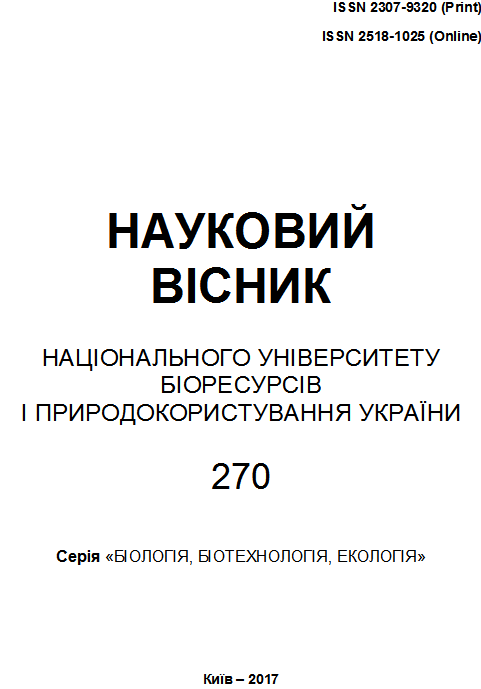HARMFUL ROOT ROT OF SPRING BARLEY
Abstract
The distribution and harmfulness of root rot of barley is studied. The disease is widespread throughout the vegetative period of spring barley and covers 30.0% of plants during the germination period, 40% – tillering period and 60.0% during the milky-wax ripeness of plants. The intensity of the disease is in the range from 10.0% to 15.0%, depending on the phase of development.
The influence of the damage of barley on the elements of the structure of the crop and on the biometric indices of plants was determined.
Growth and development of spring barley plants significantly slowed down with increasing degree of their damage, as evidence shows with strong disease development - 75-100% height of the plant decreased by 20,3-24,45cm, compared with healthy (90,25cm). A similar pattern was observed in relation to the decrease in the length of the root and its mass, depending on the degree of development of root rot.
The defeat of plants by root rot in our studies significantly influenced the elements of the structure of the crop. The most sensitive element of the structure of the crop that reacts to the pathogen, is the number of seeds from one plant. So, with the development of the disease 25 and 50%, this indicator decreased by 2.95 and 5.40pcs. Respectively, and at 75 and 100% - at 8.40 and 9.95pcs.
References
Buga, S.F. (1990) Integrovanaiy sistema zachitu iachmenia ot bolezney [The integrated system of barley protection against diseases]. Uradzhai,152 p.
Geshele, E.E. (1982) Metodologicheskoe rykovodstvo po sisteme zernovuh kyltyr [Methodical guidelines for the phytopathological assessment of cereals]. Odessa,78 p.
Dospehov, B.A. (1985) Metodica polevogo oputa [Methodology of field experience]. Agropromizdat, 351 p.
Luhmenev, V.P. (1998) Yield and quality of grain in connection with damage to rust and root rot in Orenburg region // The quality of crop production and methods of its improvement (materials of the regional scientific conference). - Ufa: BSAU,. 125-129.
Mikhailina, N.I. (1970) Kornevaia gnil iarovoi pshenitcu v Saratovscoi oblasti I agrotehnicheskie sposobu boribu s ney. V kn. Kornevui gnuli xlebnux zlakov I meru boribi s nimi [Root rot of spring wheat in the conditions of the Saratov region and agrotechnical methods of fighting it. - In: Root rot of cereals and measures to combat them] Moscow, 33-36.
Methods of phytopathological and entomological studies in plant breeding / Nauch. Works of VASKhNIL; Ed. Yu.N. Fadeeva and A.A. Kuzmicheva. -M .: Kolos, 1977. - 185 with.
Seeds of agricultural crops. Methods for determining quality: ISO 4138-2002. - Publication of the official. - K .: State Committee of Ukraine, 2003. - 173 p.
Nemchenko, V.V., Gilev S.D., Galaktionov K.V.(2002) Efectivnue priiomu ispolzovaniia fungicudov I biopreparatov na zernovuh kylturah [Effective methods of using fungicides and biologics on cereals]. Kurgan, 42.
Nedorezkov, V.D. (2002) Biologicheskaia zashita pchenitcu ot boleznei v usloviiah Iujnogo Urala [Biological protection of wheat from diseases in the conditions of the Southern Urals]. МСХА,173.
Nizharadze, T.S. (2004) Sravnitelinaia ocenka vliianiia fizichescih, himicheskih I beologicheskih metodov predposevnoi obrabotki semian na ustoichivost k bolezniam, rozvie I productivnost zernovuh kyltur v Lesostepi Srednogo Povoljia [Comparative evaluation of the influence of physical, chemical and biological methods of presowing seed treatment on disease resistance, development and productivity of cereals in the forest-steppe of the Middle Volga region]. Author’s abstract. Diss. Cand. S.-. N. - Kinel: Samara State Agricultural Academy, 24 .
Politiko, P.M. (1985) Efectivnost fungicudov [Effectiveness of fungicides]. / P.M. Politiko, L.N. Nazarova, S.S. Sanin, Plant protection. №12.,7.
Talanov I.P. (2001) Agrotehnica protiv kornevuh gniley [Agrotechnics against root rot] Protection and quarantine of plants, №4., 30.
Chumakov, A. Y., Zakharova, T. I. (1990) Vredonosnost bolezney selscohozaistvenuh kyltyr [Harmfulness of diseases of agricultural crops]. Moscow, 126.
Downloads
Published
Issue
Section
License
Relationship between right holders and users shall be governed by the terms of the license Creative Commons Attribution – non-commercial – Distribution On Same Conditions 4.0 international (CC BY-NC-SA 4.0):https://creativecommons.org/licenses/by-nc-sa/4.0/deed.uk
Authors who publish with this journal agree to the following terms:
- Authors retain copyright and grant the journal right of first publication with the work simultaneously licensed under a Creative Commons Attribution License that allows others to share the work with an acknowledgement of the work's authorship and initial publication in this journal.
- Authors are able to enter into separate, additional contractual arrangements for the non-exclusive distribution of the journal's published version of the work (e.g., post it to an institutional repository or publish it in a book), with an acknowledgement of its initial publication in this journal.
- Authors are permitted and encouraged to post their work online (e.g., in institutional repositories or on their website) prior to and during the submission process, as it can lead to productive exchanges, as well as earlier and greater citation of published work (See The Effect of Open Access).

